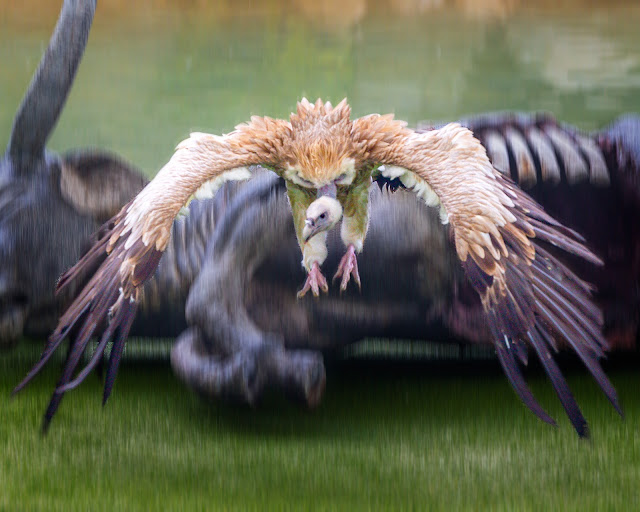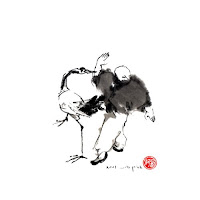Bird Paradise @ Mandai Singapore
Poses of Evocation
Sleep Resting Pose
Preening Pose
Synchronized Pose
Wings Spreading Pose
Running Pose
Standing Pose
The poses
of the birds possess evocative powers, which may have aroused the inspiration of ideas and visions for many cultural and aesthetic creations.
One of
the poses that can be easily spotted is the dreamy pose of sleep resting, the
composure of which possesses such stillness, laziness and silence that it
instills calmness and serenity in us. When the bird communities gather in their
roosts, their social nature dictated that they behave in group and display
their poses as if synchronized and choreographed. After the meal, the birds
will spend a lot of their time leisurely and meticulously preening their
features. Their necks will twist and turn in all directions and angles, as they
deeply indulged in the state of self-grooming.
I
recall some of the yoga poses that name after the birds, like the Pelican poses
and the Bird of Paradise pose. These poses are characterized by the forms,
structures and movements of the named bird. In more advanced yoga poses like
the Crane pose, the Peacock pose and the flying Pigeon pose, our human hands
are conceived to be the feet of the birds, while our legs become their wings or
tails. It takes great strength, stamina and balancing skill to lift the whole
body up in the air and pose like a crane, a peacock or a flying pigeon,
although these poses seem effortless and easy to the birds.

The Pelican Pose
The Crane Pose
The peacock Pose
The Flying Pigeon Pose
A spiraling ripple is created when a duck raised its head high while flapping its wings in a shallow pond. The scene has reminded me of a Tai-Chi sequence - it starts with uplifting body and spreading hands, then followed by a sudden downward twist of the hip and the swing of the arms. The rotating movement has created an imaginary air current encircling around the performer. This Tai-Chi sequence has a beautiful name called " White crane spreads its wings".
I could
imagine that the power, precision and speed of a vulture that swoops down a
prey from the sky is what would have inspired some Chinese kongfu master to
create the combating style termed, the Fist of Eagle. Likewise, the swift turning movement of the
neck and the peak of the crane, may have inspired them to imagine that their long
arms are the bird’s neck and their flexible hands become the bird’s peak, thus
creating the combating style of the Fist of Crane.
In a
bird-show at the theme park, the poses of the birds and the trainers are highly
synchronized in order to deliver a spectacular show. For instances, in a scene of demonstrating the ability of the bird to catch its food in the air, a trainer is signaling to a bird crouching on a branch by his sharp staring eyes and still composure, informing the bird to get ready
to leap off, going after the food that will be thrown into the air. In a feeding demonstration, the movement of the rising hands and lifting head of the trainer is mimicked by the performing bird;
that it also stands prominently tall and upright as that of the trainer, so as to show off clearly the
fruit in its peak to the watching audiences.
Background:
Bird Paradise and Its design
The popular Jurong Bird Park had been closed last year for relocation. It was reopened in May 2023 at Mandai and renamed as Bird Paradise. Being developed by a pragmatic government administration, the design does not employ extravagant iconic forms and structures for grabbing media attention, instead the emphasis is on building up the foundations and fundamental frameworks for the park, making sure that they are strong, resilient and sustainable, enabling it to grow, adapt and blossom overtime.
The new park has three design characteristics that have caught my attention in my first visit this July:
Firstly, the intertwining networks of elevated tree-top broad walks that ramp up and down the terrain of the hilly landscape, and bring the visitors as close to the birds in their natural habitats as possible. The journey of bird watching is like flying together with the birds, passing through trees, streams and rocks, with attractions and views at every turns.
Secondly, the air-conditioned pods that scatter around the park, connecting the various routes of the broad walks at every 100+m, interval. These pods have multiple functions, serving as the resting stations, mini educational museums, control gates and direction markers all at one. The idea of pods is aptly responsive to the local hot and humid climate, as visitors will find it a great relief to cool themselves down conveniently along the journey without the need to detour. The pods have also enabled the breakdown of the enormous amount of educational contents of birds into bite size information, presenting them at the right location in an interesting and interactive ways.
Thirdly, the undulating hilly terrain of the site has been fully utilized and taken advantages of, turning the park into a kind of three-dimensional, roller coaster ride experience.
Being new, the park does have its fair share of unsatisfactory design and inadequate functions. Particularly when the park is situated on the flat ground, for instance, the Crimson wetland zone, the design is not only uninspiring but also functionally inadequate. Perhaps, without the natural hilly terrain as the sources of inspiration, the designer has run out of fresh ideas.
Besides having the birds as the shining stars of the park, what has made the visit even more memorable is the warm smiles of the bird trainers and keepers. They are well trained professionals and many of them are also bird enthusiast.
JS 。 Photography
July 2023
Canon 6d . 70-200 mm f 2.8



























Comments
Post a Comment